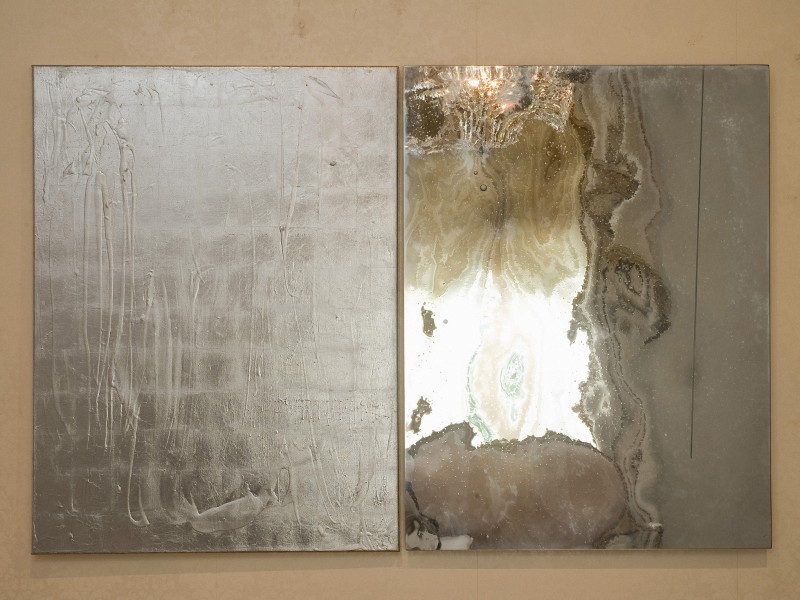If you travel around Melbourne’s Yarra River and glance across to the skyline on the Richmond side, you cannot miss the arched and glowing rainbow sign spelling ‘Our Magic Hour’. It’s the work of New York-based Swiss artist Ugo Rondinone, commissioned in 2004, and it graces the roof of Naomi Milgrom’s fashion headquarters for the Sportsgirl/Sussan Group which she owns. The installation is part of Milgrom’s contemporary art collection, which champions the work of leading contemporary artists (both Australian and International) in all their variety. The collection is displayed throughout the busy offices—as well as on the roof—of a building suffused with good design principles and natural light (in 2009, the building won the prestigious National Award for Commercial Architecture from the Australian Institute of Architects). The choice and display of the works reflects Milgrom’s active engagement with both business and contemporary art. Her key tenet is that art, architecture, fashion and design should challenge, inspire, (may) be beautiful and change the way we think, live and work.
Milgrom has contributed to these spheres for many years. She has been Chair of L’Oreal Melbourne Fashion Festival, Chair of the Australian Centre for Contemporary Art (ACCA), a trustee of the National Gallery of Victoria, and a keen supporter of the Australian Chamber Orchestra and ACMI (Australian Centre for the Moving Image), to name just a few of her broad activities. Her interests extend beyond the arts into medical research (she sat on the Board of the Howard Florey Institute of Medical Research for fifteen years), educational initiatives, and currently sits on the Boards of The Centre of Ethical Leadership and Melbourne Business School, both at the University of Melbourne. Of course, active engagement with established organisations such as these is an important role, both to share business and managerial expertise, and often to provide financial support. It is a well established model but Milgrom regularly transcends it. Not content to support existing institutions, she has also been the driving force behind new and important initiatives and projects.
In 2013, Milgrom presented her first independent initiative, an exhibition by Belgian provocateur of the fashion/art world, Walter van Bierendonck, in partnership with RMIT University. The exhibition, Dream the World Awake, was presented in the University’s new flagship building, The RMIT Design Hub, designed by architect Sean Godsell, which presides in cool modernist-style splendor over the northern end of Melbourne’s CBD grid. With Milgrom’s international connections to the global contemporary art world, Tate Modern’s Director, Chris Dercon, opened the exhibition (he has championed van Bierendonck’s work for many years). The exhibition was only one part of a program of talks, master classes, teaching modules and other related events to engage students. Its legacy was a generation of students shaped by a shared experience of creative practice, design and thought.
In 2014, the not-for-profit Naomi Milgrom Foundation was created as an operational foundation to initiate and develop ambitious projects across contemporary artforms. This form of active support for the arts extends well beyond traditional models and institutions. It fits with current thinking in philanthropy and cultural policy, crystallised by Harvard strategy guru, Michael Porter, that emphasises the creation of “shared value” between government, business and philanthropy. In October 2014, the second of these major initiatives, MPavilion, will be presented in Melbourne with the support of the City of Melbourne, the Victorian State Government and the Australian Council.
Melbourne’s Queen Victoria Gardens are divided from the National Gallery of Victoria and the Arts Centre by a broad avenue and mega tram stops, and are easily overlooked. They are home to John Robinson’s The Pathfinder, 1974, (better known as The Hammer Thrower), the bronze athlete caught in the act of spinning, usually without his hammer, which is regularly stolen. Tom Bass’, The Genie, 1973, a form of Egyptian cat or lion has an oriental gaze and a back and mane so flat that it is an implicitly sanctioned children’s climbing frame. The floral clock, whose kitsch garden planting is changed twice a year, has told the time since 1966 when it was donated to Melbourne by a group of Swiss watch-makers. Numerous other Edwardian or classically inspired statues are set amongst ornamental lakes, sweeping lawns, annual flowerbeds, a trinity of palm trees and a variety of mature European and Australian trees. Pleasant, but often overlooked, the central location of the Gardens butted up against the city’s main bridge and its prized arts precinct—cries out for ambitious contemporary projects that connect to the city’s artistic network.
The MPavilion aims to fit this bill. Heralded as “a unique architecture commission and design event for Melbourne,” MPavilion has been conceived as a “meeting place for creative collaboration and community engagement—a new type of clubhouse—to enhance the lives of all Victorians”—and, for that matter, the many visitors to Melbourne from interstate and overseas. The project’s scope is ambitious: over four years, four new architectural pavilions will be commissioned as temporary pavilions in residence from October until January each year. Architects will be selected from leading local and international practitioners whose work reflects a passion for innovative and challenging contemporary design.
Internationally acclaimed, Melbourne-based architect Sean Godsell has been selected to design the first pavilion. Godsell’s RMIT Design Hub (2012) clearly influenced Milgrom’s thinking on what outstanding architecture and design can and should do to showcase new and experimental art forms and practices, as well as providing a laboratory space to inspire creative ideas and partnerships. Godsell conceived the inaugural pavilion as a simple steel structure with glazed roof. The fully automated outer skin “blooms like a flower” each day, opening up to create a semi-porous framework to hold a range of events and activities, while at night, it appears like a “mysterious box”, it offers a unique temporary space in which a range of activities can be housed.
The site has been the location for past pavilions, such as the much-loved Botanica and similar events in John Truscott’s Melbourne Spoleto Festivals (1989, 1990, 1991), the precursor to the Melbourne International Arts Festival (MIAF). The Melbourne Festival will also partner with this new pavilion, which will be launched when MIAF 2014 opens, and which will house the Festival’s contemporary design program. Where Truscott looked to historic precedents, such as Chinese pagodas and garden tea-houses, Milgrom has taken contemporary architecture and design as her inspiration.
Milgrom is the first to acknowledge the precedents for a contemporary pavilion created as a temporary space beside a permanent art museum, such as the Serpentine Gallery’s Pavilion commissions. Julia Peyton-Jones, director of the Serpentine and a close colleague of Milgrom’s, has generously supported Milgrom’s development of commissions for Melbourne. The Serpentine pavilions are presented in the central London location of Kensington Gardens, Hyde Park. Rather than spaces to show art, these temporary pavilions are the venue for a range of other activities. Beginning in 2000 with a design by Zaha Hadid, subsequent pavilions have been designed by architects Oscar Niemeyer (2003), Frank Gehry (2008) and Herzog & de Meuron (of Tate Britain fame) (2012); and by artists in collaboration with architects including Olafur Eliasson (2007) and Ai Weiwei (2012). The Pavilion commissions have allowed the Serpentine to circumvent its limitations as a historic tea house turned gallery and expanded its offering to encompass architecture and design through an extended programme of exhibitions and events, attracting a larger and more diverse local and international audience.
There are other variations. Some are intended to be more permanent. For example, the Viennese based Thyssen Bornemisza Contemporary (T-B A21) commissioned a series of ‘Art Pavilions’ as stand-alone multi-disciplinary installations. Olafur Eliasson and David Adjaye’s Art Pavilion Your Black Horizon (2005) was first presented on Isola San Lazzaro degli Armeni, as a collateral event to the 51st Venice Biennale and was then permanently installed on the Adriatic island of Lopud. T-B A21’s founder, Francesca von Habsburg, is an extensive collector of contemporary art and the pavilions married her interests in contemporary architecture and art. Hans Ulrich Obrist, prolific curator, writer and Co-director of the Serpentine Gallery, described the pavilion model in 2005 as another form, or new institution, to support artists and artists’ projects.
Other permanent examples are becoming increasingly prominent, fusing art, architecture and design as part of a globalised contemporary art world. Art Site Naoshima, in the remote Inland Sea on Japan’s main island, presents a series of house projects by contemporary artists, in empty vernacular Japanese coastal buildings. On nearby islands, there are a series of collaborative pavilion projects by contemporary architects and artists. These works are characterised by their remoteness and one often views them alone, rather than as part of an opening night crush. Instituto Inhotim, created by mining billionaire Bernardo Paz in Minas Gerais in a remote part of southeast Brazil, is a similar model.
Commenced in the late 1990s and opened to the public in 2006, they offer a unique experience of permanent pavilions commissioned specifically for solo contemporary works drawn from his permanent collection set within a 240 hectare complex of exotic gardens. They are destination art experiences in which the architecture, contemporary artwork and unique location play equal roles. Hal Foster, in The Art-Architecture Complex (2011) noted the ‘experience economy’ of art-architecture projects of this kind and drew attention to the economic cost of creating building-sized artworks and artistically conceived buildings. Such art and architectural collecting needs very deep pockets.
Milgrom’s MPavilion is not a simple replica of these models. Its free-form architecture aims to foster ideas, partnerships and collaboration. The project will work across Melbourne’s cultural landscape, involving the Melbourne Recital Centre, ACMI, the Wheeler Centre, the Robin Boyd Foundation and more than 20 other cultural partners. New technologies and social networks connect its vision and programs to a wider virtual audience. Such initiatives can have a significant impact on regional development. Richard Florida, author of The Rise of the Creative Class (2002), noted that “the economic and tourist importance of fostering design to stimulate ‘creative cities’ and engage the new ‘creative class’ has been well documented by social researchers and economists,” while the “Bilbao Effect” is now immediately recognisable.
Milgrom is acutely aware of the opportunity to boost Melbourne’s international profile, noting that “if Melbourne wants to position itself as Asia-Pacific’s hub of creativity, culture and design, we need to raise the city’s reputation as a leader in contemporary architecture and design. I know how much interest there is in design and I want Melbourne and Victoria to capitalise on this and share this excellence and creativity.” The stakes are high: according to the Department of State Development and Business Innovation, more than 195,000 people are employed in design-related roles in the State of Victoria, with the sector contributing $7.3 billion annually to the Victorian economy, generating an estimated $204 million in design-related exports. MPavilion partnerships aim to showcase Victoria’s thriving contemporary architecture and design sector and create a new legacy of design and creative thinking.
The MPavilion will leave a material legacy as well. Each pavilion is designed to be relocatable and will be gifted to the City of Melbourne at the end of its year. The aim is that they will be a permanent and ongoing contribution to the architectural quality of the city. In some ways this new form of pavilion is the contemporary version of the historic pavilions that grace the Royal Botanic Gardens and the bandstands of many regional towns. Once in their new homes, they may continue to inspire exciting programming that further extends MPavilion’s legacy. Melbourne, Australia, and Richard Florida should be pleased.
MPavilion will be presented by the Naomi Milgrom Foundation in the Queen Gardens from October 2014 to January 2015. This article is based on an interview with Naomi Milgrom AO that took place in Melbourne in May 2014. The author was Curator at ACCA during Milgrom’s period as Chair.
For more visit mpavilion.org
Related Features
-
48
-
-
-

